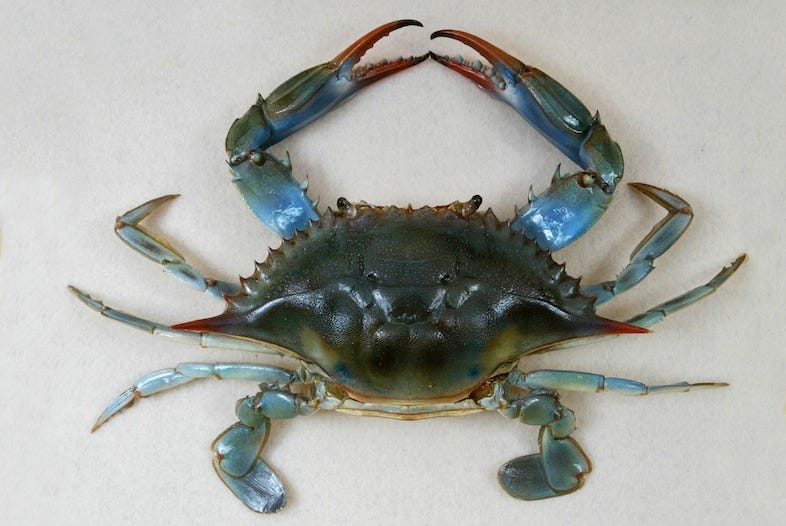Mud Monsters From Another World
Scientists have just discovered blue crabs doing something VERY STRANGE.
I’m writing about blue crabs this week (BOOK SPOILER ALERT), and I remembered this fantastic study that came out last year revealing a super weird and totally new mode of hunting never before seen in the cobalt-blue-tinged critters!
One day, while studying purple marsh crabs in Virginia, David Samuel Johnson noticed something strange.
The tide was out, which meant the salt marsh that just a few hours ago would have had water up to Johnson’s stomach was now a moonscape of mud, grass, and puddles. A water-world turned to land, in other words. And yet, a beast from the wild blue lay hidden in the muck.
Johnson, a marine ecologist at the Virginia Institute of Marine Science, remembers having his eyes trained on a female fiddler crab who was innocently picking at the mud near a small puddle. It was a scene he’d witnessed a million times over during the last 20 years of research—that is, until the puddle exploded, revealing a blue crab that had been lying in wait.
Johnson watched as the blue crab seized the fiddler, then hauled her back to the wet pit it had been hiding in. Safely back underwater, the blue crab tore the fiddler limb from limb.

Now you may be thinking, it’s a crab-eat-crab world out there, what’s the big deal? Well.
“When I first saw this, I was blown away,” says Johnson in an email. “I’d never seen a blue crab ambush fiddler crabs like crocodiles ambushing wildebeests.”
“Blue crabs aren’t supposed to be in the marsh at low tide,” he explains. “They are aquatic predators, like fish.”
Crab Outta Water
All crabs breathe with gills, but the ones that live on land, like fiddlers, simply need to keep their gills wet. Blue crabs can’t breathe at the surface though—they must remain submerged to survive.
And the feat just got more impressive the more Johnson studied it!
Over the course of 37 hours of video, he identified 33 blue crab attacks, 11 of which were successful. (33% is a highly impressive predation success rate, by the way, and it exceeds that for lions, tigers, or bears. Oh my.)
What’s more, some blue crabs were hiding out in holes no bigger than their own bodies! There’s also evidence that some of the pits are dug by the crabs themselves, which means they’re actually constructing these little murder holes.
Finally, some of the pits were super far away from the water’s edge—up to 70 meters, or three-quarters the length of a football field!
An Incredibly Risky Hunting Strategy!
If forced from their pits by a gull, heron, or even another blue crab (which Johnson also witnessed), the tiny predators would suffocate if they couldn’t find another water source. Johnson likens it to a frog hopping through the forest and getting attacked by a largemouth bass. Or maybe a crocodile ambushing a wildebeest.
My first thought was about how the Cuvier’s beaked whale can stay underwater for 222 minutes—longer than the entirety of the movie Titanic—and dive down nearly two miles so that they can hunt squid.
But strictly aquatic animals hunting on land? That’s a crab of a different color.
“I don’t know of any other aquatic predators that do this,” says Johnson. “Moray eels in the Pacific will attack crabs from tide pools at low tide, but this is not quite the same thing.”
This Sh*t Matters
Apart from just being bizarre, the finding could change the way we think about how nutrients move between ecosystems. After all, the blue crabs are literally walking into the air-world, snatching nutrients, and then pooping them out in the water. And while that may not seem like much of a deal to most of us, this shit actually matters!
At last count, there were something like 282 million blue crabs living in the Chesepeake Bay alone! And the species can be found all up and down the Atlantic Coast, as far away as Argentina. A little predation here, a little nutrient cycling there, times hundreds of millions or even billions of blue crabs… well, it adds up!
“Just as the crocodile links the river to the savanna, the blue crab connects the estuary to the salt marsh,” says Johnson at the end of his study.
And you thought the only thing interesting about blue crabs was the way they taste with Old Bay.





